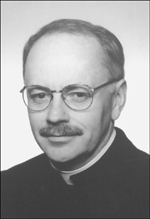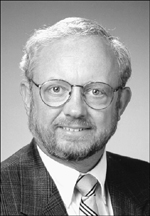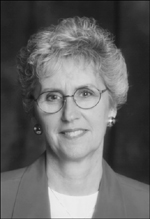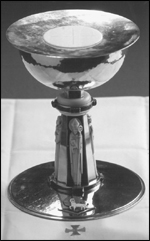 |
| The statue of Mary holding the child Jesus stands at the entrance to St. Mary’s Seminary and University’s chapel. The statue is titled Sedes Sapientiae, or Seat of Wisdom, a metaphor drawn from the Old Testament. It is an image especially beloved to Sulpicians. Seminarians affectionately refer to the statue as Sadie. More than any other, this image on last year’s Christmas card represents St. Mary’s to alumni. |
I am an alumna of the Brooklyn Bridge. A magnificent photo, shot from its center walkway by a friend, has been hanging above my desk for twenty-five years. Desks and jobs have changed—although all have been in theological education—and the picture has been a marker for me, an anchor recalling my formative years in New York City. It’s an image beyond words that lets me think what I want about it.
Theological school graduates often cherish images of their schools that are similarly evocative. They recall a sense of place that captures formative years and reminds one of friendships, teachers, perspectives on faith and the church, emergent vocations, and spiritual life. Such images are replete with smells and sounds, lighting, and changes in season. They take on meaning beyond words.
When theological school presidents come into office, they inherit more images about their place than they can ever know. And still they are responsible for articulating a sense of place that gathers up the many pasts, provides a sharp image of the present, and draws students, faculty, church sponsors, alumni, and other benefactors into the future. “Image is everything,” chant the marketers; presidents know that. The stakes are high in theological education.
Not until I completed interviews with four presidents did I fully appreciate the cost of their inheritance: each has labored to interpret his or her school in the face of seismic changes in the religious landscape over the past thirty years. The work of interpretation and repositioning is neither for the fainthearted, nor for those holding brief presidential tenures. There is too much to know, and they have to get the timing right to articulate images that will be heard, command respect, and give hope in good times and in bad.
Graduates Are the First Test
Graduates are one primary test in image-tending. “My goal is to create a sense of belonging in our alumni; they have the deepest stake in their seminary,” said my own president, the Reverend Robert Leavitt. A priest of the Society of St. Sulpice, he has led 209-year-old St. Mary’s Seminary and University in Baltimore, Maryland, for twenty years.
Leavitt thinks schools and seminaries sometimes spend too much time developing immediate, market-oriented logos and graphics. More important in his view are “those deep emblems” of a seminary tradition with which alumni and other stakeholders identify: the daily schedule, architectural profiles, the sense of time and place for study and prayer, the moods that evoke memories. These are all means by which alumni recognize their alma mater and feel connected.
Historic connections must hold while institutions respond to new challenges. Roman Catholic schools preparing prospective priests, for example, must attract students from a shrinking pool of men who believe they are called to ordination. These schools must keep faith with dozens of bishops and vocation directors who now (or will in the future) sponsor these seminarians for their dioceses.
In the case of St. Mary’s, Leavitt’s challenge in 1980, when he was appointed president-rector, was to renew commitment to the school’s founding mission of preparing seminarians for priesthood. At the time, a feasibility study for a capital campaign demonstrated that St. Mary’s alumni and publics were confused about the seminary’s role. The image had blurred.
Was St. Mary’s going to be primarily a seminary preparing future priests or a school for ministry, lay and ordained? Many schools with decreasing enrollments had chosen the latter course. At a time when the numbers of priestly candidates were declining, there seemed to be an implicit mandate to shift attention to the growing market of laity and seize the opportunity that that provided. The new president-rector believed his task was to reawaken confidence in the priesthood while at the same time creating new theological opportunities for the laity.
 |
| Robert Leavitt believes that his role as president-rector at St. Mary’s is strengthened because he teaches systematic theology and spirituality to all first-year seminarians. |
Leavitt felt responsible for creating hope that St. Mary’s would succeed by deepening its core identity as a seminary. Without that identity, the school could not keep trust with its bishops or its alumni. Yet as its former associate dean, Leavitt was committed to maintaining St. Mary’s evening division, the Ecumenical Institute of Theology. The institute, founded in the ecumenical wake of the Second Vatican Council, served (and serves) the clergy and laity of many denominations in the Baltimore community.
St. Mary’s weathered its era of uncertainty and today is in the top third of Catholic seminaries in enrollment. It has the strength and financial resources to incorporate new dimensions into the seminary’s culture.
Faculty are united around the education and formation of diocesan priests, and several also teach courses in the Ecumenical Institute. Alumni and other benefactors have a clear image of an institution anchored in the priestly formation program. They also know that St. Mary’s reaches out to embrace alumni and other priests with opportunities for theological updating and continuing formation in a new program, the Center for Continuing Formation.
Clarifying St. Mary’s image took time, and Leavitt, like the others interviewed, said the school community is a tough jury. What the seminary says about itself must mesh with the memories and impressions of its stakeholders. Images that call an institution forward create a moral obligation. Cynicism is deep in our society. “It’s one thing to articulate dreams,” said Leavitt, “but quite another to create the momentum for students and alumni to make them happen.”
Image-making at Other Schools
 |
| Charles Bouchard |
Three other presidents faced similar challenges in defining their schools. The Reverend Charles Bouchard, the Dominican president of Aquinas Institute of Theology for the past eleven years, took charge of an institution that had moved in the early 1980s from Dubuque, Iowa, where it had prepared men for the priesthood, to the campus of St. Louis University. In St. Louis its graduate program educates priests, lay women and men, and members of religious orders for leadership in the Catholic Church. In addition, it sends faculty to assist the dioceses of Oklahoma City and Colorado Springs in training lay people for ministry. Teaching the art of preaching, long associated with the Dominican tradition, has become an identifying characteristic (Dominicans are known formally as the Order of Preachers).
Bouchard described the challenge of projecting an image for Aquinas in these times as answering the demand for practicality. “We try to get energy, forward movement, and usefulness [into our images],” he said. “We have to be very practical about what will help the church and its leaders.”
But a president does not carry the burden alone. Sometimes a president must contend with faculty members or graduates who may fail to explain the school well. According to Bouchard, presidents must “set the tone, be preemptive in shaping the culture” so that faculty and alumni especially know what “feels right” in interpreting the school. This means “repeatedly repeating the mission so that everyone gets it.”
The Reverend John Mulder, nineteen-year president of Louisville Presbyterian Seminary in Kentucky, said he inherited a good set of images. He didn’t know the school, though, before he was interviewed for the presidency. Consequently, he said, it took time to see the images so that he could “give voice to them.” He engaged in a long series of lunches with key faculty and board members during which he listened to how they understood the school. His job, he said, was not to invent the image of Louisville Presbyterian Seminary, but develop “congruent images” that corresponded to perceptions of reality.
When Mulder came to Louisville, the school was perceived as a regional seminary, but it was the only Presbyterian school that linked the lower Midwest with the upper South. It was also the only one that served both the northern and southern Presbyterians, who then were in separate denominations. When northern and southern Presbyterians merged in 1983 to form the Presbyterian Church (U.S.A.), Louisville Seminary’s bridging function was no longer distinctive, so Mulder had to guide the school in revising its image. When the new united denomination established its national headquarters in Louisville, the school began to attract more national attention. “Bridge-building” took on new meanings, such as bridging differences among Christians and bridging the gap between the academy and the churches. Louisville Seminary, which now draws more students nationally, founded an annual book award and created the Louisville Institute. The national Grawemeyer book award recognizes outstanding and creative works that promote understanding of the relationship between human beings and the divine. The Institute brings together leaders and scholars of religious organizations for the study of American religion.
 |
| John Mulder |
The Reverend Barbara Brown Zikmund, who concludes her ten-year presidency of Hartford Seminary in Connecticut this June, inherited another sort of image challenge: continuing the task of interpreting dramatic changes in institutional mission to graduates and regional publics. In 1972, Hartford had phased out nearly a century of preordination education for the United Church of Christ and its predecessor bodies, espoused a nondenominational stance, and focused its program on study of religious leadership, congregational life, church and society, Islam, and Christian-Muslim relations. Hartford also sold its traditional gothic buildings to the State of Connecticut and in 1981 erected across the street a spare, white, glass-and-tile contemporary building designed by the now-well-known architect Richard Meier.
 |
| Barbara Brown Zikmund |
Zikmund first worked toward congruence by engaging in an institution-wide process of writing a mission statement. She learned what Leavitt had also realized, not to make too much of the quest for a logo. After three years, she realized that the building itself could be the logo. Hartford Seminary, redesigned in mission and building, sits in a Victorian-era neighborhood. Its spare white building stands out.
As we spoke, Zikmund was preparing for Alumni Day, which this year had attracted the largest crowd in years, including many who had not been back since graduation. She planned to use the building in her conversation with them, because it “jars” people and, therefore, becomes a means for interpreting the school’s purpose. “The building doesn’t sit easy, but then should a building for theological education sit easy?” she asked. “The place itself,” she continued, “says, ‘Heads up! This is not business as usual, but a place that approaches issues of faithfulness with new questions and explores new answers.’”
In fact, Zikmund believes this building fits the school’s constituency: individuals who are “seekers, mavericks, those out of the mainstream.” She observed: “The building’s lightness invites the outside in. It’s a safe place, open to differences. It fits a mission to support faith and living in a multifaith and pluralistic world.”
The Payoff of Clarity
Each of the four presidents works at making clear the image of his or her school. The task is as challenging for schools pursuing their historic mission, like St. Mary’s and Louisville, as it is for those that have taken another course, like Aquinas and Hartford.
 |
| Hartford Seminary’s contemporary building and current mission are a clear contrast to the Gothic edifice and educational emphasis that preceded them. |
When it comes to sharing hard news, all four called for truth-telling. Mulder said that people who support theological education are “committed, well-educated, sophisticated, and invested in what the institution’s about.” Any attempt to manipulate them “will ultimately be self-destructive.”
Leavitt agreed. When bad news happens, he feels the right approach is honesty and candor. “Bad news can’t be either overmanaged or avoided,” he said, “and airbrushing doesn’t work. It’s a question of timing: how a president takes the community from stages of embarrassment, shame, and confusion and moves them to confidence.” Resources have to be mobilized on all levels to rebuild confidence and to keep people believing in themselves.
These presidents aren’t engaged in selling the Brooklyn Bridge. Image-keeping for them is more like building a working theology for their institutions, one that can be preached. It shouldn’t be a long homily, however. Leavitt, who has come to favor the short, focused message, said there is little time to impart nuances. He has learned not to “burden an audience by trying to synthesize everything about the institution. It’s always more complex than can be spoken.”
 |
| This paten and chalice, used often in the seminary chapel for the daily Eucharist, belonged to the late Raymond E. Brown, who served for many years on St. Mary’s faculty. They are a visible reminder of the faithful priesthood of this great New Testament scholar. |
Bon Mots from Presidents for Presidents
Don’t be oblivious. Your school has an image both within and without. Your job is to discern and guide it.
Create occasions within the school to repeat the mission, imprint the image on staff, faculty and students. Sabotage from within is very difficult to counteract.
— Charles Bouchard, O.P.
When you “spin,” you are articulating your school’s image so that those who are well-disposed toward you can recognize themselves, their interests. You have no moral obligation to make your critics happy; nobody is required to disbelieve in themselves.
Leadership is creating images that are true and believable, hopeful and real. These will pull an institution in the right direction—toward what it can become.
— Robert Leavitt, S.S.
On the road, ask people “tell me what you know about us.” You not only find out about image, but learn how they will lock on to your message.
Don’t forget the power of road signs with exit numbers on major highways in your area. They state your place on the landscape and require you to do public business with the state on behalf of your institution.
— Barbara Brown Zikmund
When an image needs to be updated, it is less a matter of change than of moving the camera to a new angle or having light fall on the subject in a different way.
Don’t give too much weight to any contrary image that crops up. It will blow over in time. My job is to make sure that the image the institution wants to convey is clear and helps the public get beyond the other.
— John Mulder